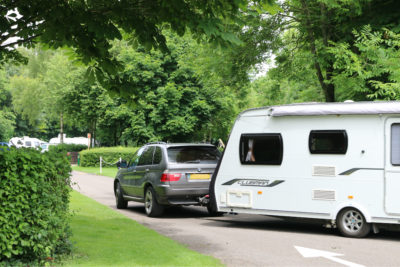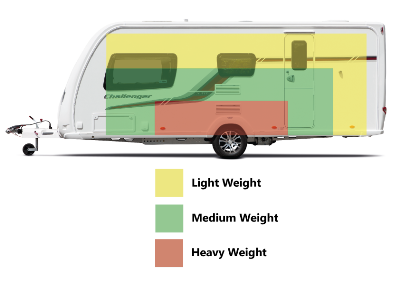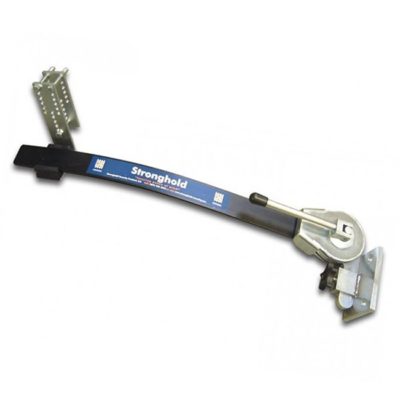Overloading a caravan with too much weight will not only cause your car to struggle when accelerating or climbing hills, but will also affect its handling and stability, which makes overloading a real concern to your towing safety.

As a caravan insurance specialist for more than 20 years, we’ve come across many stories of caravan overloading that have led to devastating accidents and large insurance claims. As well as the effects on the safety of your towing outfit, overloading will also affect your fuel efficiency as the engine of your car will struggle to pull the weight.
In this expert video and blog post we give some top tips on correctly loading your caravan for safe towing:
The 85% rule
To load your towing caravan correctly you need to be aware of a few ratios and weight restrictions.
- Your caravan should have a MTPLM (Maximum Technically Permissible Laden Mass, sometimes referred to as maximum laden mass) as advised by the caravan manufacturer. The MTPLM refers to the maximum permissible weight of your caravan when fully loaded. Essentially it’s an indication of how much food, clothes and equipment you can carry inside your caravan whilst towing it. The maximum permitted weight of such items carried inside your caravan is often referred to as user payload.
- It’s recommended that the MPTLM of your chosen caravan should not exceed 85% of your car’s kerb weight. Your car’s kerb weight can usually be found in your car manual, but if unsure contact your car’s manufacturer or local dealer.
- There’s an exception to this rule. If your car’s recommended maximum towing weight (i.e. the amount it can pull safely as advised by the car manufacturer) is lower than 85%, you should stick to this lower amount as your upper limit for your loaded caravan’s weight.
Measuring the weight of your caravan and contents
The easiest way to weigh items that are going into the caravan is using a set of luggage scales rather than attempting to see your bathroom scales with an awning bag in your arms! It may seem like a time consuming activity to weigh your equipment and luggage, but for the vast majority of items it will only need to be done once. Simply keep a record of what everything weighs in a safe place and then on each trip tot up what you’re taking, plus the weight of any luggage which can obviously differ from one trip to the next.
Once you have weights for everything that’s going into the caravan you can simply add this to the manufacturer’s given weight of your caravan to find out your caravan’s laden weight (MPTLM). As mentioned above this is the weight which should not exceed 85% of your car’s kerb weight or your car manufacturers given ‘maximum towing weight’.
Key items to weigh:
- Awning – including the canvas parts, poles, pegs, straps and any flooring used in the awning
- Bikes
- Portable TVs and radios etc
- BBQ
- Gas bottles
- Pots and pans
- Bedding
- Clothing
- Stored food such as tins, rice, pasta, beer, wine, gin, etc
Remember when considering the weight in your caravan there’s no reason to drive with any liquid in your fresh or waste water tanks – the fresh water tank can be quickly filled up when you arrive at the campsite and the waste water (and any remaining fresh water) can be emptied before you leave.
Where to store the heaviest items
It’s important that the majority of the weight being carried inside the caravan is over the caravan’s wheels, and as low as possible to the floor, as this provides the greatest towing stability and lowest centre of gravity for the towing unit. If you position heavy items too close to the front of the caravan then you’ll put unnecessary weight on the nose of the caravan which will compress your car’s rear suspension, whereas too much weight near the back of the caravan could cause the nose to lift, reducing traction for the car’s rear wheels – both of which negatively affect the balance and handling of the car.

The diagram above gives a rough guide as to how the weight in your caravan should be distributed during towing. Notice that heavy weight items should be placed over the wheels, medium weight items should be no higher than window level, and only your lightest items should be placed in overhead lockers, or in the back of the caravan. Generally speaking though most things are better stored as low as possible in light weight boxes or bags, as the vibrations of towing will cause items to move around during transit, so the last thing you want are damageable goods falling out of cupboards and breaking or damaging worktops.
The noseweight of your caravan is the downward force exerted on the tow ball of your car. You should be able to find out your vehicle’s maximum noseweight figure in your handbook but a typical figure is around 75kg, although a larger estate car might be 90kg and a 4×4 or SUV might be able to handle up to 100kg. Remember this is the noseweight, i.e. the weight exerted on the tow ball, and not the maximum weight your car can pull, which is obviously much higher.
Of course, whilst this article outlines some of the maximum values you should never exceed, it’s always better to aim for loading your caravan as lightly as possible. It’ll make towing and manoeuvring the caravan easier and will greatly reduce your fuel consumption, saving you money at the petrol pumps. Even if you’re packing just an awning and some clothes though, be sure to stick to the weight positions in the diagram above, placing the heaviest items (such as your awning) over the caravan’s axle.
Also consider the layout of your caravan when packing up for your trip away. For caravans with kitchens and washrooms at the back, don’t be tempted to store heavy clothes or heavy food items in the end lockers. It’s best to pack these in your car until you get to your final destination and then transfer them into the lockers.
Don’t forget carrying heavy items in the boot of your tow vehicle can help keep your caravan’s laden weight (MPTLM) down, but be sure not to exceed your car’s maximum weight limit too!
Other ways to increase your caravan’s towing stability
Many new caravans will also come fitted with a stabiliser bar alongside the caravan’s hitch, and this helps to increase your caravan’s towing stability and avoid excessive wobble on uneven road surfaces. If your caravan doesn’t have one fitted then consider buying one from a dealership. They are relatively cheaply and provide extra stability during towing.

There are also some more advanced devices on the market which intelligently improve towing stability, such as the Al-Ko ATC (Automatic Trailer Control) and BPW iDC – these electronic devices prevent your caravan ‘snaking’ by applying small amounts of braking to the caravans wheels automatically when the device detects loss of stability in the caravan being towed. These devices use digital sensors to calculate when to apply the correct amount of braking pressure, and only when needed, to greatly improve the stability of the towing outfit and avoid your caravan snaking behind you – which can in a worst case scenario cause complete loss of stability and a major accident.
We offer a 5% caravan insurance discount for caravan’s fitted with an approved electronic anti-snaking device. For more information visit our caravan security page.
Over to you…
Got any tips to share on safe loading? Add your comments in the box below.


Because the one on the caravan could be irelevant. There are THREE nose weights to take into account: The car manufacturers, the tow bar manufacturers and the caravan manufacturers. The lowest is the one that should be chosen regardless of which one it is. Printing it on the caravan although helpful could be misleading.
Why is so little importance made to the nose weight? That makes a huge difference to the stability. I think positioning everything forward of the axle then moving things backwards till the nose weight is correct. If you can get away with not having the awning over the axle but forward a bit that’s far better.
Thanks for your comments Rob. Our next video will be about measuring and adjusting noseweight – we didn’t want to make them too long. Plus you can read more here – How to measure and adjust your carvan nose weight
I agree with Dave excessive speed is a problem but like Dave I have also been towing for over 40 years and in my opinion overloading is the major problem that cause accidents, we have all witnessed the caravans arriving on site and unloading everything but the kitchen sink .Modern caravans are not designed to carry all of this additional equipment, the caravan manufacturers have all reduced the MPTLM to enable their vans to be towed by the smaller more economic cars which are not capable of pulling heavy weights. I have paid extra to Swift to upgrade my rating plate to enable me to comply with the law. I carry as much as possible in my car which is a medium 4×4 with an engine that is more than capable of towing my van, yes it’s not economical but it’s kerb weight means that I can tow safely within the specified limits and allows me to tour with out worrying that I am a) breaking the law and b) that I am still insured if God forbid I do have an accident, because as good as Caravan Guard are at paying out after an accident if the caravan is shown to be overloaded then I am sure that the insurance would be null and void !
As stated in my previous reply last night todays modern caravans are not fit for purpose if you want to tour with them.
I actually weighed my caravan whilst on holiday in Cornwall and was surprised to find that I was 200kg’s overweight even though I carry the awning, chairs barby etc in the back of my 4×4. I only have the empty clean and waste containers in my van plus clothing and food. When I got home I weighed each individual item and was very surprised at the results. So I sent a copy of my findings to both the caravan club and camping and caravan club, neither of which have made any comments apart from acknowledging my letter and the reason for this is is that I have surmised that the the MPTLM of today’s modern caravan is to cater for the smaller enginned cars and the caravans are not fit for purpose ie if you want to tour don’t take any clothes or food with you.
Thanks for your comments Brian. We’d suggest passing on your concerns and findings to the national body for caravan safety the National Caravan Council.
Clearly safety is the issue here and having caravanned for over 40 years,our first caravan was a Sprite 400 with Gas Mantles and a foot pump for water, Speed is ,in my view, the most dangerous current problem. The new cars, much more powerful than those of old are capable of towing trailers and caravans at very dangerous speeds. That is why the authorities impose rules on towing, a speed limit of 60mph and overtaking rules on 3 lane highways. The number of caravans and those towing trailers that overtake me on motorways is frankly idiotic. Far in excess of 60mph and in the 3rd lane blatantly breaking the law and putting everyone at risk. I assume the speed cameras used by the relevant agencies are designed to interpret this and fines dispatched, as do the Toll Booth cameras on the Autoroutes on the continent identifying if you are towing or not or am I wrong.
Thanks for your comments David. It is important for everyone’s safety that caravanners stick to the speed limit and tow responsibly.
I have just insured my new caravan with yourselves and I question your ruling about discounts for drivers who have proof of attending a towing coarse.
Firstly, I was never asked this question?
Secondly, I have been towing trailers for over 45 years, 18 years with a double axle and over 40cwt in tow when I was self employed.
Why am I classed as un-experienced and not given the discount?
Thanks for getting in touch Dave . I have looked into this for you. A towing course is one of several ways of achieving a 10% introductory no claims discount, however looking at your record, you have received the full 3 years 20% no claims discount as a result of your claim free caravanning experience.
As you initially went online to obtain a quote, the information about towing experience is found within the help section relating to the question “How many years have you held claim free caravan insurance?”. As you qualified for the full no claims discount online, the adviser would not have asked you about your towing experience.
Thanks again for taking your caravan insurance with caravan Guard and if you have any other queries please give us a call.
Talking to other caravaners, getting the nose weight down to 75Kg is a common problem. Loading the rear of the caravan can cause stability problems, even with IDC. I notice that some manufacturers have moved the fridge to alongside the cooker, perhaps causing heat transfer from the oven. Why do the manufacturers not move the body of the caravan rearwards on the chassis? An unloaded nose weight of approximately 60 Kg would solve the problem.
noseweight is a legal requirement why is not stamped anywere on caravan or car
Looking for reply to m glaser question 20th Feb please ? Thanks
Hi Graeme
We’ve added a response to the webpage now. We hope this helps.
Thanks
Craig
I have a caravan with an mtplm of 1470kg and a car with a curb weight of 1475. However the manufacturers permiitted towing weight is 2000kg. Is thisd an exception. I dont understand the following. There is an exception to this rule. If your car’s recommended maximum towing weight (i.e. the amount it can pull safely as advised by the car manufacturer) is lower than 85%, you should stick to this lower amount as your upper limit for your loaded caravan’s weight.
Hi Michael
I ran your query past a leading caravan journalist.
He said, “The towing limit as set by the towcar manufacturer is one which has been calculated under ‘laboratory’ conditions. If it is below the ‘van’s MTPLM we would strongly recommend that the owner consider changing the car. If it is above the MTPLM – the most likely case – we strongly recommend that the owner sticks to the 85 per cent rule, i.e the total weight of the caravan does not exceed 85 per cent of the car’s kerbweight.”
I hope this helps but let us know if you’d like further clarification.
Kind Regards
Craig
Caravan Guard
why is there no mention about twin axle trailers when it comes to weights and nose weights ?
Your article is very comprehensive but it fails to mention probably the most effective way of reaching your destination safely and in one piece.Having loaded your car and caravan with great care, finally setting off on your journey, feeling safe and confident with the stabiliser fitted and ATC on,
KEEP YOUR SPEED DOWN WHEN TOWING.
Remember that they are speed limits, not targets….
The best advice to give to anyone about to concider towing anything is to take a proper driving coarse to include reverseing proceedure, I have full HGV Class 1 and full PSV licences plus over 1,000,000 miles driving experience driving these classes of vehicle. My question is when is an insurance company going to take things like this into account when quoteing premiums.
Hi Robert
Sorry for the delay in responding. If a person is new to caravanning but has completed a towing course, we reward them with our 10% introductory no claims insurance discount.
Kind regards
Craig
Caravan Guard